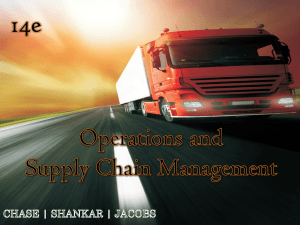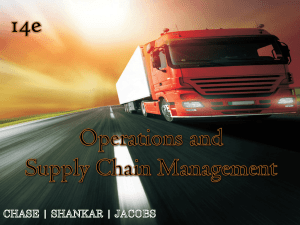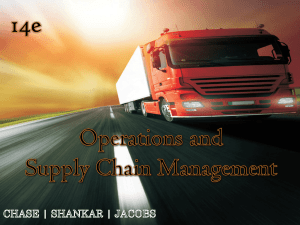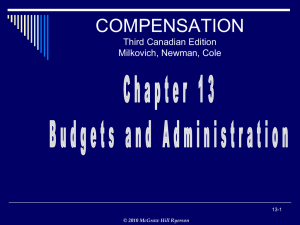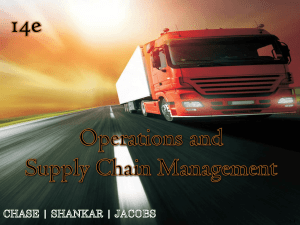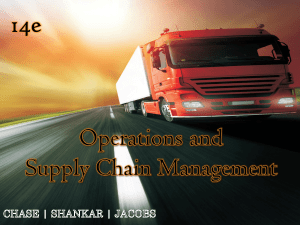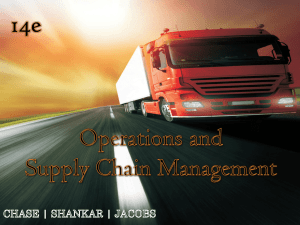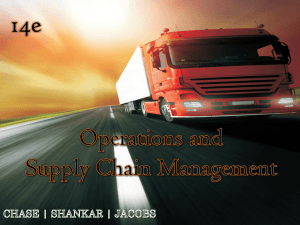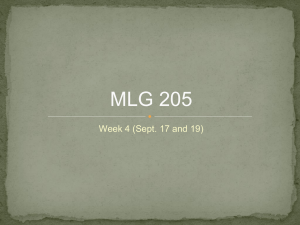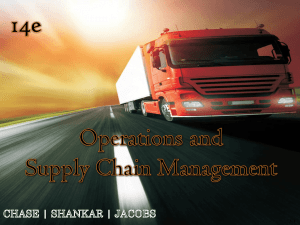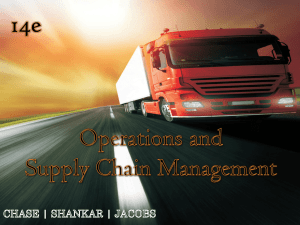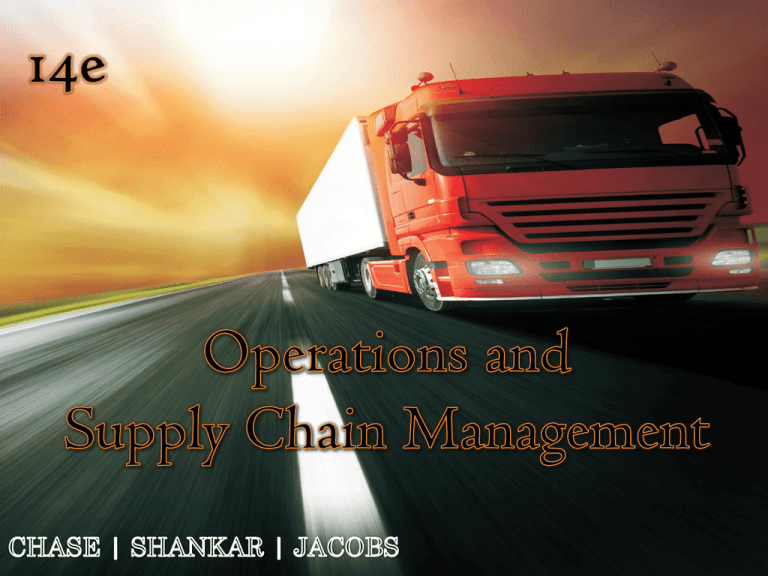
17–1
Chapter Seventeen
McGraw-Hill/Irwin
Copyright © 2014 by The McGraw-Hill Companies, Inc. All rights reserved.
17–2
• LO17–2: Explain how ERP integrates business
units through information sharing.
• LO17–3: Illustrate how supply chain planning
and control fits within ERP.
Copyright © 2014 by McGraw Hill Education (India) Private Limited. All rights reserved.
• LO17–1: Understand what an enterprise resource
planning (ERP) system is.
• LO17–4: Evaluate supply chain performance
using data from the ERP system.
17–3
• ERP systems are, first and foremost,
integrated.
Copyright © 2014 by McGraw Hill Education (India) Private Limited. All rights reserved.
• A comprehensive software approach to
support decisions concurrent with
planning and controlling the business.
17–4
Connecting functional units with ERP
The need for standardization
Support of MPC decisions
Transaction processing
Copyright © 2014 by McGraw Hill Education (India) Private Limited. All rights reserved.
What is ERP?
Performance metrics
The ERP experience
17–5
– A comprehensive decision support software
that plans and controls
– A software system that integrates all
applications from different functional areas
Integration through a common database
Copyright © 2014 by McGraw Hill Education (India) Private Limited. All rights reserved.
• ERP may mean different things.
– Able to facilitate MPC activities
17–6
17–7
Copyright © 2014 by McGraw Hill Education (India) Private Limited. All rights reserved.
– Consistent numbers across all applications
– Software should be:
Multifunctional (manufacturing, service, etc.)
Integrated (handled only once across all
applications)
Modular
Able to facilitate MPC activities
Copyright © 2014 by McGraw Hill Education (India) Private Limited. All rights reserved.
• ERP requires
– Routine decision making
– Capacity for all transaction processing
17–8
– Supports analysis of data for decision
support
– Helps make intelligent decisions
– Note: People make decisions not software
• Bolt-on software modifies and enables
new approaches to decision making
• Modifies existing procedures to make it
more efficient
Copyright © 2014 by McGraw Hill Education (India) Private Limited. All rights reserved.
• ERP software
17–9
– People make the decisions; software
provides them with better tools and
information.
Copyright © 2014 by McGraw Hill Education (India) Private Limited. All rights reserved.
• Helping users make decisions about
running the business
17–10
• Data warehouse software may be added
to facilitate queries not built into the
ERP system.
Copyright © 2014 by McGraw Hill Education (India) Private Limited. All rights reserved.
• An ERP system is designed to process
business transactions in real time,
working from a single database.
17–11
17–12
Copyright © 2014 by McGraw Hill Education (India) Private Limited. All rights reserved.
Eliminates
reposting of
data (errors)
Ensures a
common vision
instantly
displayed
Copyright © 2014 by McGraw Hill Education (India) Private Limited. All rights reserved.
Data entered by one functional area
updates all other functional areas and the
data are processed in real time.
17–13
Production planning
MPC
Activity
Support
Material planning
Copyright © 2014 by McGraw Hill Education (India) Private Limited. All rights reserved.
Forecasting
Inventory
management
17–14
– What is demand?
– What is inventory?
– How are exchange rates determined?
– What transfer costs apply (for internal
transactions)?
– What labor rates are applied?
Copyright © 2014 by McGraw Hill Education (India) Private Limited. All rights reserved.
• Without standard terminology,
integration is impossible.
17–15
• Designed to measure the impact of
decisions on the entire supply chain.
• Avoids development of functional silos
by developing metrics that reflect the
entire supply chain.
Copyright © 2014 by McGraw Hill Education (India) Private Limited. All rights reserved.
• Developed by the Supply Chain Council.
17–16
Cash-to-cash cycle time = Inventory days of supply + Days of sales
outstanding – Average payment period for material
Procurement
cycle
• Purchase cost of
material
• Accounts payable
Manufacturing
cycle
• Raw materials
inventory
• Work-in-process
• Finished goods
inventory
Copyright © 2014 by McGraw Hill Education (India) Private Limited. All rights reserved.
• Integrates the finance function with
purchasing, manufacturing, and
sales/distribution
Sales and
distribution cycle
• Distribution
inventory
• Accounts receivable
17–17
Purchasing
pursues cost
rather than
quality.
Manufacturing Distribution
builds long
focuses on cost
runs rather
of delivery
than
stages instead
responding to of total system
customers.
costs.
Copyright © 2014 by McGraw Hill Education (India) Private Limited. All rights reserved.
Functional silos – Each area is responsible for
optimizing its own operation, with no
consideration for how the overall firm is affected.
17–18
17–19
Copyright © 2014 by McGraw Hill Education (India) Private Limited. All rights reserved.
17–20
Copyright © 2014 by McGraw Hill Education (India) Private Limited. All rights reserved.
Sd
S
d
AR
d
Accounts receivable days (ARd)
ARd
Average daily cost of sales (Cd)
Cd Sd CS
I
Cd
Average days of inventory (Id)
Id
Accounts payable cycle time (APd)
APd
Cash-to-cash cycle time
Copyright © 2014 by McGraw Hill Education (India) Private Limited. All rights reserved.
Average daily sales (Sd)
AP
Cd
Cash to cash cycle time ARd I d APd
17-21
17–21
Copyright © 2014 by McGraw Hill Education (India) Private Limited. All rights reserved.
• Sales over last 30 days = $1,020,000 S d S 1,020,000 34,000
d
• Accounts receivable = $200,000
• Inventory value = $400,000
• Cost of sales = 60% of total sales
• Accounts payable = $160,000
ARd
30
AR 200,000
5.88 days
d
34,000
Cd Sd CS 34,000(0.6) 20,400
Id
I
400,000
19.6 days
Cd
20,400
APd
AP 160,000
7.84 days
Cd
20,400
Cash to cash cycle time ARd I d APd 5.88 19.6 7.84 17.64 days
17-22
17–22
– Integration of a global company
– Process improvement
– Simplified training
– Strategic direction
– Organizational flexibility
Copyright © 2014 by McGraw Hill Education (India) Private Limited. All rights reserved.
• Eli Lilly and Company
– Set of global policies
17–23
• To maintain data accuracy and realize
efficiencies, information must be captured at the
initial entry, using documented processes.
Copyright © 2014 by McGraw Hill Education (India) Private Limited. All rights reserved.
• Redundant transactions must be reduced or
eliminated.
• Processes need to be changed to support the
data needs of the ERP system – hardware and
software alone isn’t sufficient.
17–24
• IT economies of scale can be obtained
from supporting fewer hardware and
software platforms.
Copyright © 2014 by McGraw Hill Education (India) Private Limited. All rights reserved.
• The company must define a
comprehensive set of performance
measures, with policies and goals that
correspond to these measures.
17–25

